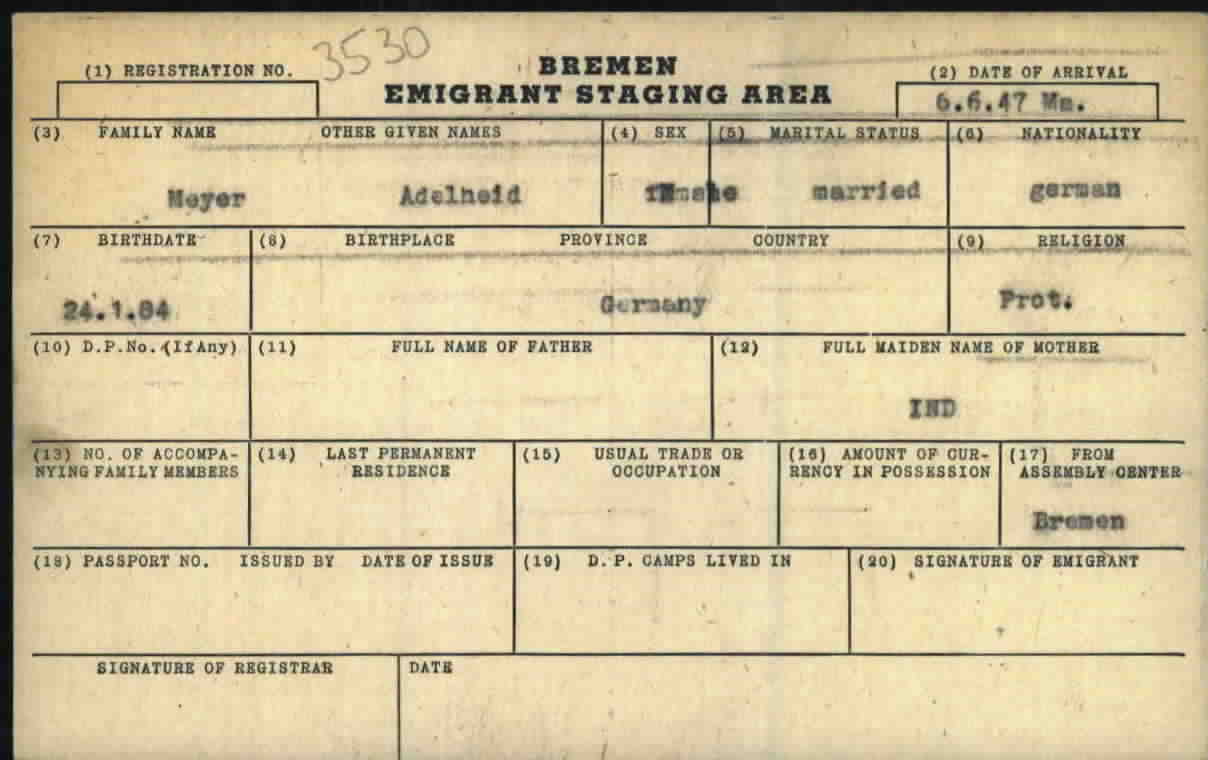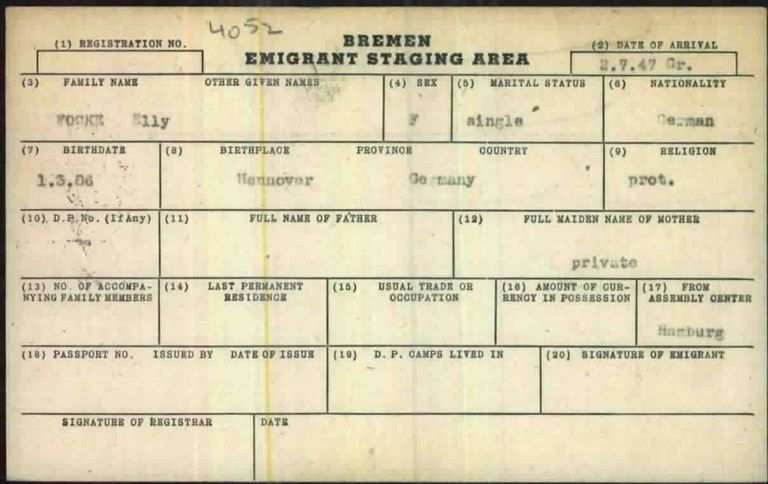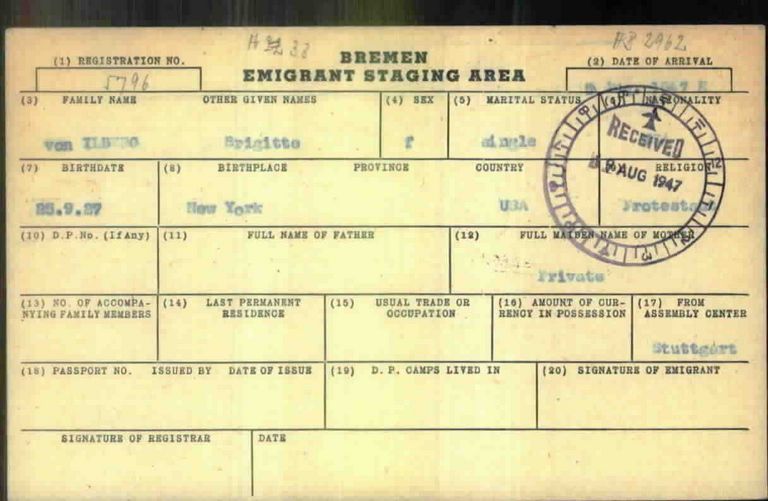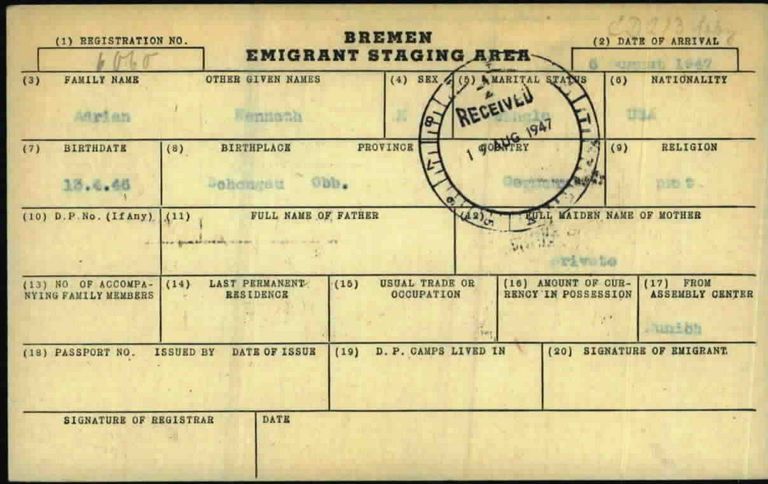Page of
Page/
- Reference
- Intro


Staging centers were one of the last stations that DPs went through prior to emigrating. From 1946, one of the largest Emigrant Staging Areas was located in Bremen. Many DPs and other emigrants left from there to travel primarily to the USA. Employees of UNRRA, and later the IRO, issued special cards for them which were used to note when and were the person was emigrating to, among other information.
Staging centers were one of the last stations that DPs went through prior to emigrating. From 1946, one of the largest Emigrant Staging Areas was located in Bremen. Many DPs and other emigrants left from there to travel primarily to the USA. Employees of UNRRA, and later the IRO, issued special cards for them which were used to note when and were the person was emigrating to, among other information.
Questions and answers
-
Where was the document used and who created it?
After the end of World War II, thousands of DPs left Europe from Bremen. Around two weeks before their ship sailed or their plane took off, they – and other emigrants who were not DPs – would move into a camp that was part of the Bremen Emigrant Staging Area. At times, there would be several thousand people attending orientation courses on the language, everyday life and culture of their destination countries. UNRRA and later IRO employees assigned the emigrants to a ship, and doctors examined them for illnesses that could have prevented them from leaving at the last minute. The establishment of these staging centers made it possible for the planes and ships in particular to set off on time and fully occupied.
In Bremen, UNRRA and later IRO employees were responsible for the emigrants residing in at least three camps. Camp Tirpitz, a former barracks in the Bremen district of Gröpelingen, housed up to 1,800 emigrants from the spring of 1946. Camp Grohn was probably established in 1948 for a maximum of 5,000 people, and Camp Lesum opened in the winter of 1950/51. Together these camps formed the Emigrant Staging Area. This is where UNRRA and later IRO employees created the cards for the emigrants, some of which are preserved in the Arolsen Archives today.
- When was the document used?
Although many people emigrated via Bremen, very little is now known about the Emigrant Staging Area there. Furthermore, there were many camps in and around Bremen, and the term Emigrant Staging Area is not precisely defined. This makes it difficult to pinpoint the date on which the cards began to be used there. Researchers roughly estimate that there were special staging camps in Bremen at least between the spring of 1946 and the end of 1951. Most of the cards examined thus far come from people who boarded a ship in Bremen in 1947.
- What was the document used for?
In the months and years after the end of World War II, many DPs decided that they did not want to return to their countries of origin but instead preferred to start a new life in a different country. UNRRA and later the IRO, in particular, therefore helped more and more people emigrate. The IRO alone had 25 of its own ships for this purpose, but there were planes as well. The process for emigration – officially known as resettlement – was precisely defined for the DPs, and there were special camps for different phases. After DPs and their families had been chosen by a national selection committee in a resettlement center on the basis of an interview, medical exams and professional tests, the DPs would move to a staging center shortly before their departure. They usually only stayed in the staging center for about two weeks, because all of the emigration formalities – including customs checks for their luggage as well as security checks – had to be completed beforehand. The basic idea behind the staging centers was to assemble the emigrants as close to their departure point as possible so that their planes and ships in particular could set off on time and fully occupied. If passengers were unable to travel for health reasons, for example, there were always other emigrants in the staging centers who could quickly take their place. The number of emigrants was large. According to the historian Wolfgang Jacobmeyer, more than 700,000 people emigrated with the IRO’s help before the organization was dissolved in December 1951; there were 260,000 such emigrants in 1949 alone. Most of them moved to the USA, followed by Australia, Canada and Israel.
The DPs left Europe either via the port of Genoa in Italy or via Bremen in northern Germany. In Bremen, there was an entire Emigrant Staging Area for DPs and other emigrants. It consisted of several large camps in the city districts of Grohn and Lesum as well as the former Tirpitz barracks. There was also a temporary embarkation center in Bremen, the job of which was later taken over by the staging area camps. The Bremen-Grohn camp alone had space for up to 5,000 people. Since a ship with around 1,200 emigrants set sail every two to three days on average, there was a high rate of turnover. The UNRRA and IRO employees in Bremen probably created the Bremen Emigrant Staging Area cards to maintain an overview of the occupants of the camps. The cards are like routing slips which were used by the registrars, doctors and other officials to record information. However, the cards were apparently never completely filled out. Instead, the employees responsible for registration only noted a few of the emigrants’ personal details. Later on they added their departure date, destination and the name of the ship. For the steps in between – including medical exams and transportation assignments (“movement documentation”) – there were probably other cards used that have not been preserved.
- How common is the document?
IRO employees helped around 1.2 million people worldwide return to their countries of origin or, more often, to emigrate. They arranged transportation for the people who, as a consequence of World War II, found themselves living in countries in Western Europe – such as Austria, Belgium, Denmark, Germany and Italy – or in places such as China, the Philippines, East Africa, Lebanon, Syria or Turkey. Researchers have not yet determined exactly how many people emigrated via the camps of the Emigrant Staging Area in Bremen. For this reason, it is also not possible to say how many cards were produced there, nor whether there was a card for every single emigrant.
The Arolsen Archives do not have Emigrant Staging Area cards for all of the DPs who emigrated via Bremen. Only a small number of these cards reached the ITS, the predecessor to the Arolsen Archives. Since the ITS needed the cards to search for missing persons, the employees organized the cards from Bremen following an alphabetical-phonetic system and placed them in a large general index. This postwar card file (Nachkriegszeitkartei, Collection 3.1.1.1) now comprises around 3.5 million documents. Filing the cards this way made it possible to respond to tracing inquiries more quickly because the employees only needed to look in one card file instead of several. Unfortunately, this also means it is no longer possible to determine how many Bremen Emigrant Staging Area cards have been preserved. But in the near future, modern computer technology will find the answer: clustering techniques will make it possible to virtually reassemble the cards from Bremen – as well as other card files.
- What should be considered when working with the document?
It is important to remember that not everyone who was issued a Bremen Emigrant Staging Areacard was a DP. To bring in money, the IRO also sold spaces on its ships to people whose emigration was arranged by sponsors, families overseas or other aid organizations. In the IRO’s first year of work alone – between July 1947 and June 1948 – around 44,200 people who were not DPs left Europe on IRO ships and planes. For example, some IRO ships even carried Germans who had not been persecuted by the Nazis. Just because a card exists for a person does not mean the person was a DP.
Looking at several different cards from the Bremen Emigrant Staging Area, it soon becomes clear that most of the fields have been left blank. On all of the cards examined thus far, only fields (2) to (9) as well as (12) and (17) have been filled out. The only information on the back of the cards is a departure date stamp. These cards were therefore probably not the only documents used in Bremen for the emigrants. Why the cards were never fully completed is still unclear. To find additional information about a particular person mentioned on a Bremen Emigrant Staging Area card, it is worth checking the passenger lists preserved in the Arolsen Archives. These lists can be viewed directly in the online archive, and they often provide more details about the person, such as their destination address and whether they were traveling alone or with other family members.
There is also a different card from Munich that looks very similar to the ones from Bremen. However, the camp in Munich that used these cards was an assembly center, not a staging center. DPs spent a longer time in the assembly centers to complete all of the formalities for their departure. This also means that the cards served a different purpose.
If you have any additional information about these cards, we would appreciate it very much if you could send your feedback to eguide@arolsen-archives.org. New findings can always be incorporated into the e-Guide and shared with everyone.
Help for documents
About the scan of this document <br> Markings on scan <br> Questions and answers about the document <br> More sample cards <br> Variants of the document


